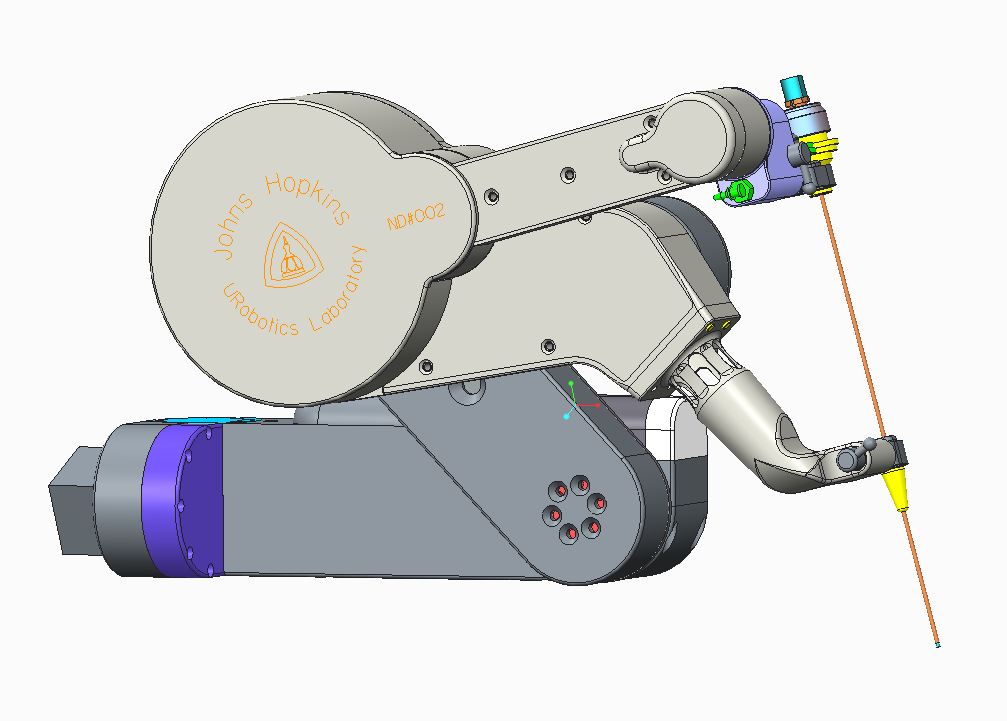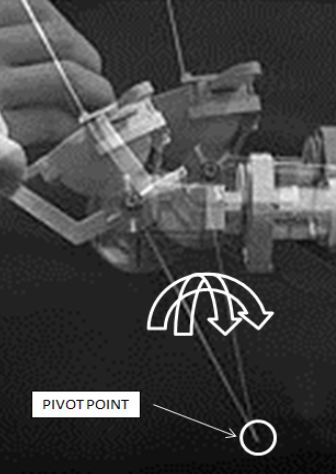Contact Us
CiiS Lab
Johns Hopkins University
112 Hackerman Hall
3400 N. Charles Street
Baltimore, MD 21218
Directions
Lab Director
Russell Taylor
127 Hackerman Hall
rht@jhu.edu
Last updated: 1:10PM 5/7/2012
The Revolving Needle Driver (RND) is a needle driver which can be attached to the end of an AcuBot, a Remote Center of Motion (RCM) module with five stages: Bridge-mount > Linear pre-positioning stage (XYZ) > Support Arm > RCM > RND. The RND excels at orienting, inserting and spinning a needle; it is also capable of measuring force.
 As it currently stands, there is a small but noticeable error ( 3mm ) in the location of the RCM. The RCM’s two axes of rotation are neither perpendicular nor intersecting, which causes it to move upon revolving either axis. This completely defeats the purpose of having an RCM, which offers the benefit of having a stationary pivot point around which it is possible to work. Since any error in the location of the RCM will cause even more errors to propagate along the linkage of the robot, a small displacement in the location of the RCM could lead to a very large displacement in the tip of the surgical device attached.
As it currently stands, there is a small but noticeable error ( 3mm ) in the location of the RCM. The RCM’s two axes of rotation are neither perpendicular nor intersecting, which causes it to move upon revolving either axis. This completely defeats the purpose of having an RCM, which offers the benefit of having a stationary pivot point around which it is possible to work. Since any error in the location of the RCM will cause even more errors to propagate along the linkage of the robot, a small displacement in the location of the RCM could lead to a very large displacement in the tip of the surgical device attached.
The goal for this project is to quantify and correct the RCM of the RND robot. We hope that by being able to track the tool tip very accurately with an optical tracker, we will learn how to build more precise and accurate RCM’s in the future.
Many surgical robots today, such as the well-known da Vinci, have either mechanical or virtual RCM’s which allow them to operate in small spaces. By placing the RCM at the entry point in the patient, surgeons are able to obtain a very wide range of motion from a very small incision, which minimizes collateral tissue damage, blood loss, recovery time, scarring and infection.
 How much error is acceptable in the RCM is very much dependent upon the type of surgery being performed. For example, a 1mm difference in abdominal surgery is likely to be much less disastrous than a 1mm difference in ocular surgery. If RCM’s can be consistently and accurately maintained, surgeries requiring high precision will become much safer and easier to perform.
How much error is acceptable in the RCM is very much dependent upon the type of surgery being performed. For example, a 1mm difference in abdominal surgery is likely to be much less disastrous than a 1mm difference in ocular surgery. If RCM’s can be consistently and accurately maintained, surgeries requiring high precision will become much safer and easier to perform.
FPEki275WUc
Polaris Tracker Accuracy Quantification
The manufacturer of the Polaris tracker states that the device has an error of 0.3mm, but they do not specify to what this 0.3mm refers to (overall displacement? Displacement in each cardinal direction?) Furthermore, they state nothing about the orientation of the markers.
 In order to determine a more accurate understanding of the capabilities of the tracker, we will use a highly accurate CNC machine to move the markers and give us a reference point. By using the CNC’s readings as the “expected” values (as the CNC has an accuracy on the order of a micron), we can better quantify the accuracy of the optical tracker.
In order to determine a more accurate understanding of the capabilities of the tracker, we will use a highly accurate CNC machine to move the markers and give us a reference point. By using the CNC’s readings as the “expected” values (as the CNC has an accuracy on the order of a micron), we can better quantify the accuracy of the optical tracker.
In order to take the readings, the tracker is attached to the XY stage of the machine, and the marker is placed on the tool tip, or Z-stage. In doing so, we can precisely move the tracker and the marker to obtain readings in a 3D volume.
At each location within the CNC, 500 readings with the tracker are recorded. By doing so, the values can be denoisified and averaged to give a more accurate result that is unaffected by mechanical vibrations in the room. Furthermore, we hope to quantify the effects of taking readings at the trackers “sweet spot” and compare them to readings taken from other locations.
An extensive analysis on precision and accuracy, as well as repeatability of these tests will be performed. We also hope to test different types of trackers using our CNC method and compare the results.
RCM Error Quantification
Using the Polaris tracker, the RCM of the module will be observed in order to quantify the errors generated in the current state of construction. Markers will be placed at the tool tip, as well as a base reference, in order to more easily see the motion of the robot and its RCM. With the markers attached, the robot will be moved to several poses and orientations, taking measurements in a method similar to those of the CNC-comparison procedure.
 After performing these readings, we will have to two RCM axis locations relative to the tool tip in tracker space. We then want to compare these axis locations with the axis locations in our original CAD model.
After performing these readings, we will have to two RCM axis locations relative to the tool tip in tracker space. We then want to compare these axis locations with the axis locations in our original CAD model.
Mechanical Dissection of the Robotic Needle Driver
The RCM of the RND robot will be partially disassembled and analyzed in order to study which factors contribute to the RCM error. The components of the robot, its link parameters, and axes of motion, will be compared with the ideal counterparts of the CAD model and corrected as much as possible, given the current design of the robot.
1. URobotics Laboratory Access
2. CNC Machine Time - Needed to quantify the tracker accuracy.
3. Time with RND - Needed to analyze, dissect, and fix RND.
4. Optical Tracker Time - Needed to calibrate tracker, measure errors, and implement the correction algorithm.
Note: All members will work on most portions of the project, however, the responsibilities listed below are the lead roles of which the members will assume
Alex:
Changhan
Ryan
Polaris Optical tracking system Error Quantification
RCM Error Quantification
RCM Targeting Error Quantification
Here is a link to our code and data: https://www.dropbox.com/s/sfve3dj5v9gcfkt/DATA_Copy.zip